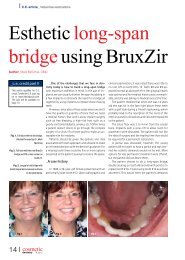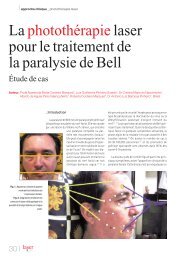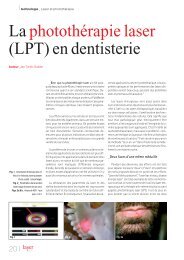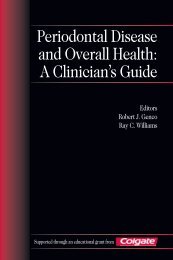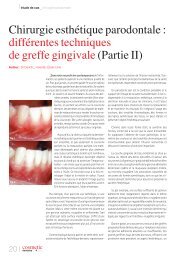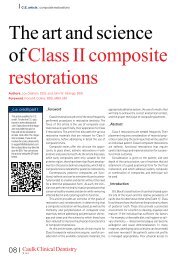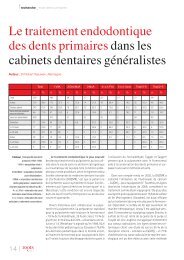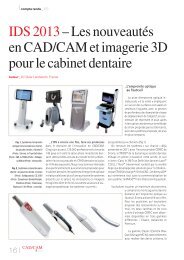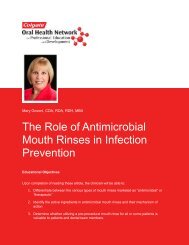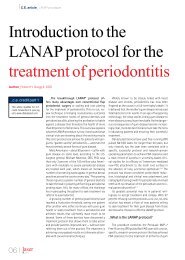Periodontal Disease and Overall Health: A Clinician's Guide
Periodontal Disease and Overall Health: A Clinician's Guide
Periodontal Disease and Overall Health: A Clinician's Guide
Create successful ePaper yourself
Turn your PDF publications into a flip-book with our unique Google optimized e-Paper software.
CHAPTER 3 Infection <strong>and</strong> Inflammation 37maintained, tissue destruction continues <strong>and</strong>inflammation persists. If pro-resolution signalsare weak, neutrophils are not removed<strong>and</strong> monocytes/macrophages maintain aphlogistic phenotype. This results in furtherproduction of inflammatory cytokines <strong>and</strong>perpetuation of the inflamed state.New Treatment ParadigmsIt is reasonable to suggest that the underst<strong>and</strong>ing<strong>and</strong> ability to manipulate resolutionof inflammation may provide a newtreatment paradigm for inflammatory diseases,local <strong>and</strong> systemic. Although hum<strong>and</strong>ata are not yet available, there is a growing<strong>and</strong> promising literature from in vitro work<strong>and</strong> animal models that supports the bene -ficial actions of resolution agonists both onperio dontal <strong>and</strong> other systemic diseases. 5The Role of Pro-Resolution MediatorsExamples of the actions of therapeuticpro-resolution mediators in periodontal diseaseinclude over-expression of lipoxin A 4intransgenic rabbits protecting against perio -dontitis <strong>and</strong> atherosclerosis. 43 In anotherstudy, topical treatment with resolvins (-3fatty acid derived resolution agonists, videinfra) prevented more than 95% of alveolarbone destruction in rabbits. Moreover, histologicalanalysis revealed few, if any, neutrophils in the tissue <strong>and</strong> little tissue damage.At the same time, the numbers of osteoclastswere also found to be reduced. In addition,treatment of periodontitis with resolvins systemicallyreversed the observed increase inCRP <strong>and</strong> IL-1 levels. Finally, in establishedperiodontal disease, resolvins prevented furthertissue destruction, <strong>and</strong> both gingival <strong>and</strong>osseous tissues that were lost during diseasewere regenerated. 44Resolvins, lipoxins, <strong>and</strong> protectins havealso been shown in animal models to havebeneficial impact on a variety of other inflammatorydiseases. For example, lipoxinsstopped neutrophil recruitment <strong>and</strong> promotedlymphatic removal of phagocytes in perio -tonitis. 42 Moreover, in cystic fibrosis, lipoxinsdecreased neutrophil inflammation, pulmo -nary bacterial burden, <strong>and</strong> disease severity. 45Resolvins in a colitis model in mice decreasedneutrophil recruitment <strong>and</strong> pro-inflammatorygene expression, improved survival, <strong>and</strong>reduced weight loss. 46 In addition, resolvinsprotected against neovascularization inretinopathy. 47 Finally, in an asthma model,protectins protected against lung damage,airway inflammation, <strong>and</strong> airway hyperresponsiveness.48 Table 2 lists the impact oflipoxins, resolvins, <strong>and</strong> protectins on variousinflammatory disease models.It is conceivable that the use of proresolutionmediators in managing periodontal<strong>and</strong> other inflammatory diseases mayprove to be beneficial in humans as well.Mechanical debridement, which aims at thereduction of the bacterial load in the gingivalpocket, may help the host/patient to clearthe infection. In addition, it is possible thatthe use of locally applied pro-resolution mediatorscould prevent further tissue damage,enhance the resolution of inflammation(which would lead to healthy gingiva), <strong>and</strong>ideally result in periodontal tissue regenerationrather than scarring <strong>and</strong> repair. Moreover,resolution of inflammation at the gingi -val level may minimize systemic inflammationinduced by periodontal disease, therebyattenuating the possible negative effects ofperio dontal disease on systemic diseases.Origins of Pro-Resolution MediatorsIn order to manipulate resolution ofinflammation more effectively, it is imperativeto underst<strong>and</strong> the biological origin of the proresolutionmediators. Lipoxins (e.g., lipoxinA 4) derive from arachidonic acid after acti -vation of the 12-/5-LO or the 15-/5-LO pathways.Resolvins <strong>and</strong> protectins are bio synthesizedfrom omega-3 essential poly -unsaturatedfatty acids (-3 PUFAs), such as eicosapentanoicacid (EPA) <strong>and</strong> docosahexanoic acid



